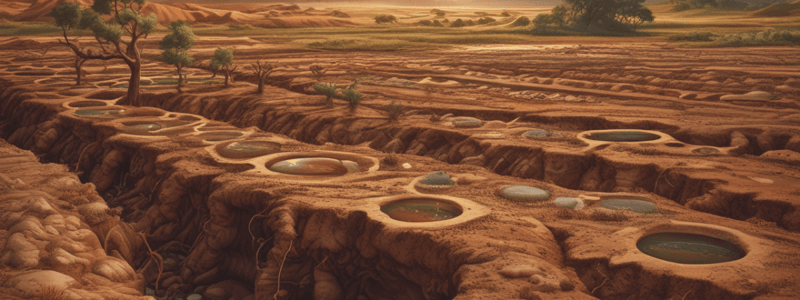Podcast
Questions and Answers
What is the effect of adding organic matter to a soil with poor CEC, such as sand?
What is the effect of adding organic matter to a soil with poor CEC, such as sand?
Increases CEC
What is the optimum pH range for most plants, and why is lime added to acidic soils?
What is the optimum pH range for most plants, and why is lime added to acidic soils?
pH 5.5-7.5; to increase available Ca cations and reduce H⁺ ions
What determines the acidity of a soil?
What determines the acidity of a soil?
Concentration of acidic ions (H⁺, Al³⁺) adsorbed onto the soil surface
What is the effect of liming on soil pH and CEC?
What is the effect of liming on soil pH and CEC?
What is the primary reason why cations such as Ca2+ and Mg2+ are attracted to soil particles?
What is the primary reason why cations such as Ca2+ and Mg2+ are attracted to soil particles?
How do polarised water molecules contribute to the formation of floccules?
How do polarised water molecules contribute to the formation of floccules?
What is the significance of Cation Exchange Capacity (CEC) in soil?
What is the significance of Cation Exchange Capacity (CEC) in soil?
What is the benefit of humus having a higher Cation Exchange Capacity than clay?
What is the benefit of humus having a higher Cation Exchange Capacity than clay?
How do plant roots remove cations from the soil solution?
How do plant roots remove cations from the soil solution?
What is the significance of flocculation in soil structure?
What is the significance of flocculation in soil structure?
Why is high humus content more beneficial than high clay content in soil?
Why is high humus content more beneficial than high clay content in soil?
Why does the addition of organic matter, such as slurry or seaweed, to a sandy soil increase its Cation Exchange Capacity (CEC)?
Why does the addition of organic matter, such as slurry or seaweed, to a sandy soil increase its Cation Exchange Capacity (CEC)?
Why is soil pH critical in determining the availability of cations for plant uptake, and what is the optimal pH range for most plants?
Why is soil pH critical in determining the availability of cations for plant uptake, and what is the optimal pH range for most plants?
How does liming a soil with low pH affect its Cation Exchange Capacity (CEC), and what is the primary benefit of doing so?
How does liming a soil with low pH affect its Cation Exchange Capacity (CEC), and what is the primary benefit of doing so?
Flashcards are hidden until you start studying
Study Notes
Flocculation
- Flocculation is the clustering of soil particles to form larger structures called floccules, which improves soil structure.
- Cations such as Ca2+ and Mg2+ promote flocculation by being attracted to the negative charges on soil particles.
- Soil particles have a negative charge, with smaller particles having more negative charges.
- Cations are adsorbed to the surface of soil particles, and polarized water holds soil particles together, trapping larger sand and silt in a floccule structure.
- High humus content is more beneficial than high clay content because humus is more fertile, holds more water, has a higher Cation Exchange Capacity, encourages more earthworm activity, and has more negative charges, resulting in an increased rate of flocculation.
Cation Exchange
- Cation exchange is the ability of the soil to adsorb cations onto its surface and exchange them for other cations.
- Cations are attracted to the negative charge of clay/humus particles and are adsorbed on the surface.
- Cations can be released into soil water (soil solution) and be replaced by others, supplying minerals to plants.
- A cation with a +2 charge (Ca2+) can replace two separate cations each with +1 charge (H+).
- Cations are removed from soil solution by plant roots.
- Colloidal humus particles have three times higher cation exchange capacity than colloidal clay particles.
- Adding organic matter to a soil with poor CEC (like sand) will increase its CEC.
- Main cations involved in cation exchange are Ca2+, Mg2+, Al3+, H+, and K+.
- Note that nitrate (NO3-) cannot be held, and sandy soils have the lowest CEC.
Soil pH
- Soil pH is the acid-base scale, measuring the concentration of H+ ions in a solution.
- Acidic soils have a pH of 0-6, neutral soils have a pH of 7, and basic soils have a pH of 8-14.
- The concentration of acidic ions adsorbed onto the surface of the soil determines the acidity of the soil.
- Acidic ions include H+ and Al3+, while alkaline/basic ions include Ca2+ and Mg2+.
- Importance of Soil pH:
- Lime increases Ca cations available for exchange (H, K, Al).
- As pH increases, the amount of negative charges on soil colloids increases, leading to greater CEC.
- Liming reduces ‘acid leaching’.
Flocculation
- Flocculation is the clustering of soil particles to form larger structures called floccules (aggregates = peds).
- Cations (Ca2+, Mg2+) promote flocculation by being attracted to the negative charges on soil particles.
- Soil particles have a negative charge, with smaller particles having more negative charges.
- Cations are adsorbed to the surface of soil particles, and polarized water holds soil particles together, trapping larger sand and silt in a floccule structure.
- Flocculation improves soil structure.
Benefits of High Humus Content
- Humus is more fertile.
- Humus holds more water.
- Humus has a higher Cation Exchange Capacity (CEC).
- Humus encourages more earthworm activity.
- Humus has more negative charges, increasing the rate of flocculation.
Cation Exchange
- Cation exchange is the ability of the soil to adsorb cations onto its surface and exchange them for other cations.
- Cations are attracted to the negative charge of clay/humus particles and are adsorbed on the surface.
- Cations can be released into soil water (soil solution) and be replaced by others, supplying minerals to the plant.
- A Cation with a +2 charge (Ca2+) can replace two separate cations each with +1 charge (H+).
- Cations are removed from soil solution by plant roots.
Cation Exchange Capacity (CEC)
- Colloidal humus particles have three times higher CEC than colloidal clay particles.
- CEC is the ability of the soil to perform cation exchange, measured by the quantity of cations that the soil can adsorb onto its surface.
- Adding Organic Matter (slurry/FYM/Seaweed) to a soil with poor CEC (like sand) increases CEC.
- Main cations involved are Ca2+, Mg2+, Al3+, H+, K+.
- Nitrate (NO3-) cannot be held.
- Sandy soils have the lowest CEC.
Soil pH
- Soil pH measures the concentration of H+ ions in a solution, ranging from acidic (0-6) to neutral (7) to basic (8-14).
- The concentration of acidic ions adsorbed onto the surface of the soil determines the acidity of the soil.
- Acidic ions include H+, Al3+, while alkaline/basic ions include Ca2+, Mg2+.
Importance of Soil pH
- Lime increases Ca cations available for exchange (H, K, Al).
- As pH increases, the amount of negative charges on soil colloids increases, leading to greater CEC.
- Liming reduces ‘acid leaching’.
- Key points to note: Lime moisture content must be controlled. Optimum pH range is 5.5-7.5, as few cations are available below 5.
Studying That Suits You
Use AI to generate personalized quizzes and flashcards to suit your learning preferences.




